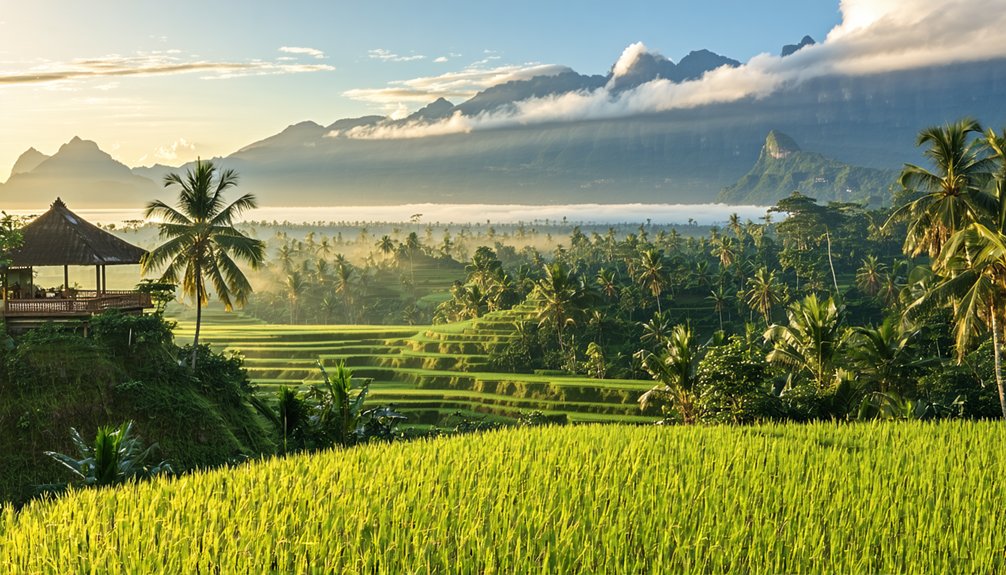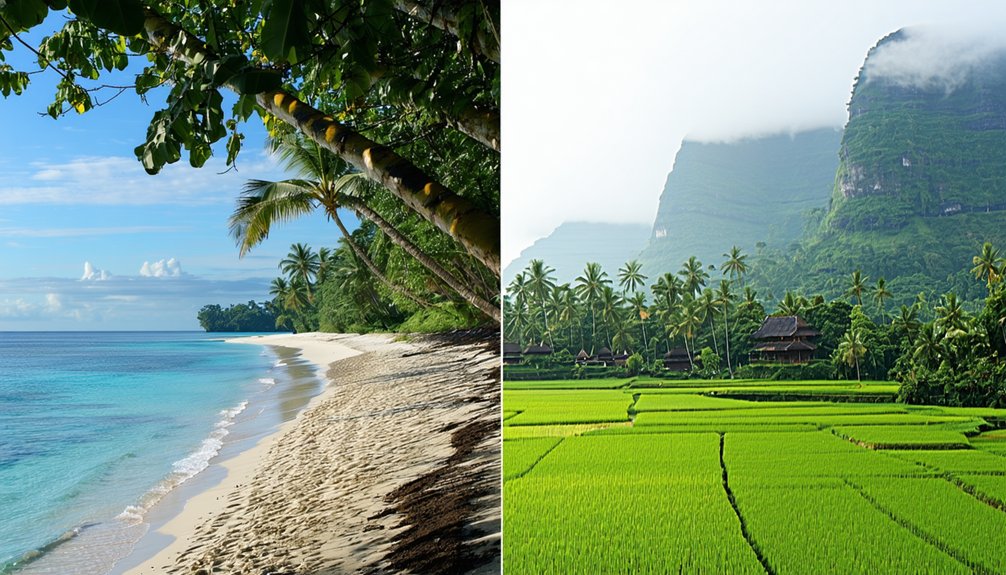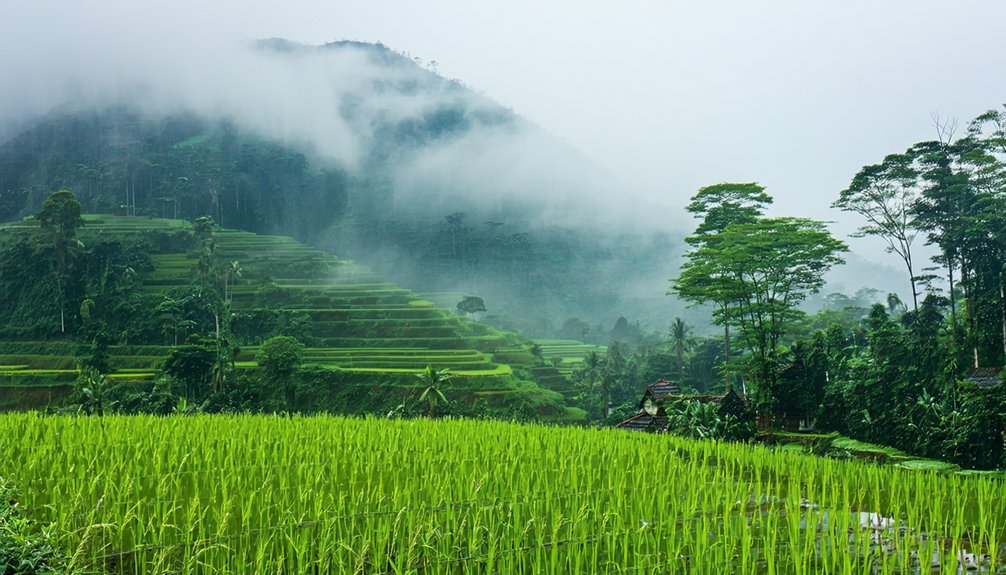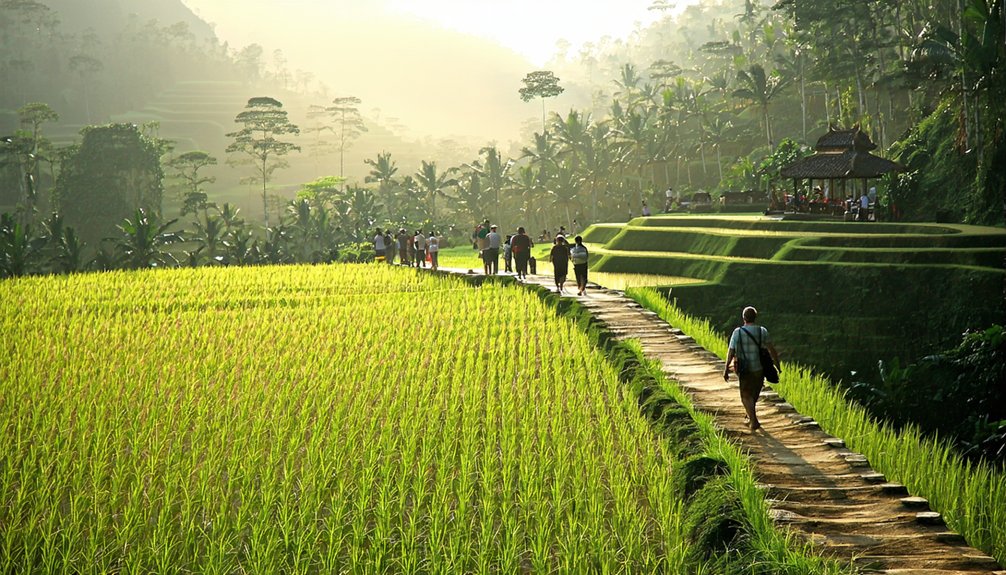The ideal time to visit Bali is during the dry season, from April through October, when you’ll enjoy clear skies and perfect temperatures between 27-32°C. You can expect minimal rainfall, lower humidity, and favorable conditions for diving, hiking, and cultural exploration. While July-August brings peak crowds and higher prices, consider the shoulder months of April-June or September-October for fewer tourists and 15-20% savings. Each season offers unique opportunities to discover Bali’s diverse treasures.
Key Takeaways
- April to October offers dry season with minimal rainfall and ideal temperatures of 27-32°C for outdoor activities.
- Peak tourist season occurs during July-August and December-January, requiring advance bookings and higher prices.
- Budget travelers should visit January-March for 30-40% discounts on accommodations and fewer crowds.
- July-September provides best conditions for diving and snorkeling with excellent visibility and manta ray sightings.
- Shoulder seasons (April-June, September-October) balance good weather with 15-20% savings on accommodations and activities.
Peak Tourist Season: What to Expect
While Bali welcomes visitors year-round, the island’s peak tourist seasons transform this tropical paradise into a bustling hub of activity. You’ll find the highest concentration of travelers during July and August, when summer holidays align with Indonesia’s school breaks, followed by a second surge during December and January’s festive period.
Be prepared for significant spikes in travel costs during these peak times. Your accommodation expenses could double, with budget hotels jumping from $10 to $20+ per night, while luxury resorts command premium rates exceeding $1,000. You’ll also face 20-30% increases in tour prices and up to 50% higher airfares during the Christmas season.
To navigate crowd congestion, you’ll want to avoid southern hotspots like Kuta and Seminyak. Instead, consider exploring quieter areas like Ubud or Nusa Dua. Planning ahead is essential – book your accommodations 3-6 months in advance for peak season visits to secure the best options. Recent data shows that international visitors tend to stay longer with an average of 2.81 nights per stay, making peak season accommodation bookings even more competitive.
Weather Patterns Throughout the Year

Understanding Bali’s weather patterns reveals the secret to planning your perfect island adventure. The island operates on two distinct seasons – dry (April-October) and wet (November-March). During the dry season, you’ll experience minimal rainfall, lower humidity trends around 75%, and consistent temperatures between 27-32°C, making it ideal for outdoor activities and water sports. August is driest among all months, offering the most reliable weather conditions.
The wet season brings dramatic afternoon showers, higher humidity reaching 80%+, and brief but intense rainfall periods. Don’t let this discourage you – morning activities remain largely unaffected. The island’s regional variations add another layer to examine: coastal areas maintain warmer temperatures while inland regions like Ubud stay cooler. Activity suitability varies by season, with diving and hiking best during dry months, while temple visits can be magical during wet season showers. Each season offers unique opportunities to experience Bali’s diverse landscapes and cultural richness.
Budget-Friendly Travel Times

You’ll find significant savings during Bali’s low season from November through April, with hotel rates slashed up to 50% and flights costing 20-30% less than peak periods. For even deeper discounts, target your travel between January and March, when tourist numbers hit their lowest point and you can secure accommodations at 30-40% below standard rates. While these months fall during the wet season, frequent rainfall provides an opportunity to explore indoor cultural activities at discounted prices. The shoulder seasons of April-June and September-October offer an attractive middle ground, combining moderate savings of 15-20% with more favorable weather conditions and fewer crowds at major attractions.
Low-Season Deep Discounts
Savvy travelers can access incredible savings by visiting Bali during its low season, which runs from November through March (excluding the December holidays). You’ll find discounted villa accommodations at 30-50% off peak rates, with luxury properties offering enticing perks like spa credits and low season dining promotions. Adventure awaits with smaller crowds at iconic surf spots and cultural sites operating at reduced capacity. While the rainy season prevails, visitors can still enjoy plenty of activities since downpours typically don’t last all day.
- Score hotel rates up to 60% off during February-March, with 3-star properties under $40/night
- Book flights 6 months ahead for 35% savings, or catch budget airline promotions under $200 one-way
- Enjoy authentic experiences at local warungs for under $3 per meal, while premium beach clubs offer 25% off minimum spends
Shoulder Month Travel Deals
The sweet spot for Bali travel deals falls during the shoulder months of April-June and September-October, when you’ll find an ideal balance of value and weather conditions. Flight availability increases while hotel occupancy decreases, creating the perfect opportunity for savvy travelers to score significant savings. Thanks to the minimal rainfall patterns during these periods, outdoor activities are rarely disrupted by weather concerns.
| Month | Average Savings | Crowd Level |
|---|---|---|
| April | 30-40% | Low-Medium |
| May | 25-35% | Low-Medium |
| June | 20-30% | Medium |
| September | 25-35% | Medium |
| October | 30-40% | Low-Medium |
During these strategic months, you’ll discover discounted rates on beachfront villas, adventure tours, and spa treatments. Take advantage of reduced competition for popular attractions and enjoy more authentic interactions with locals. Many hotels offer complimentary upgrades and added perks during these periods to attract visitors.
Seasonal Activities and Adventures

When planning your Bali adventures, timing can make all the difference in experiencing the island’s most thrilling activities. The dry season (April-October) offers ideal conditions for outdoor pursuits, with clear skies perfect for cultural photography opportunities and watersport equipment rentals at their peak availability. Several operators offer ATV quad bike tours that traverse scenic landscapes through tunnels and past waterfalls, making this activity particularly enjoyable during the dry months.
Peak adventures await during Bali’s dry season, when clear skies and optimal conditions create the perfect setting for unforgettable experiences.
- Dive and snorkel during July-September for spectacular manta ray encounters and visibility reaching 30+ meters at sites like Nusa Penida
- Take advantage of sunrise Mount Batur treks between May-September when summit success rates hit 95%
- Combine cultural festivals with adventures – catch the Bali Arts Festival in June-July for traditional performances after your rafting expedition
Water-based activities flourish in the dry season with Class II-III rapids on the Ayung River and prime surfing conditions delivering 4-6ft swells along the west coast. For budget-conscious adventurers, November-March brings significant discounts on tours and activities, though you’ll need to plan around afternoon rains.
Coastal vs. Inland Climate Differences

Understanding Bali’s distinct microclimates can dramatically shape your island experience, as coastal and inland regions offer markedly different weather patterns throughout the year. If you’re seeking beach vibes, coastal areas maintain warm temperatures between 27-32°C, though high humidity levels in different regions (75-85%) can make it feel warmer than the thermometer suggests. The two main seasons – rainy from November to April and dry from May to October – affect all regions of the island.
For a cooler escape, head inland to areas like Ubud where temperatures range from 20-27°C. You’ll still encounter high humidity, but the elevated terrain and persistent breezes make it more comfortable. The arid microclimate of Bukit Peninsula offers a unique alternative, with lower humidity and higher daytime temperatures (28-33°C). While coastal zones average 1,500mm of annual rainfall, inland areas receive double that amount, keeping rice terraces lush year-round. Coastal rains are typically brief afternoon bursts, while inland showers tend to last longer, particularly during the wet season.
Monsoon Season Insights

During Bali’s monsoon season (October-March), you’ll encounter brief but intense daily downpours, with January seeing the heaviest rainfall averaging 255-345mm. You’ll discover that most rain showers last just 1-3 hours, typically accompanied by dramatic thunderstorms that create spectacular photo opportunities between sunny breaks. To maximize your monsoon adventure, plan outdoor activities for morning hours when rainfall is least likely, and take advantage of significant discounts (30-50% off) on accommodations and activities during this green season. Visitors should note that maintaining a consistent temperature of around 28°C, the tropical climate remains warm and humid throughout the monsoon months.
Rainfall Patterns and Impact
Bali’s monsoon season transforms the island into a dramatic spectacle of tropical rainfall between November and April, peaking in January with an impressive 350mm of precipitation. You’ll experience daily downpours lasting 1-3 hours, occurring up to 27 days per month during peak season. The season brings high humidity levels reaching 85% in January. While soil erosion levels increase and wildlife population fluctuations become more pronounced, these rains bring extraordinary natural phenomena.
- Waterfall flow rates surge to 225m³/s, creating powerful displays at spots like GitGit Falls
- Rice terraces reach peak vibrancy in February-March, offering stunning photo opportunities
- Eastern regions receive 15% less rainfall than western Bali, providing strategic refuge for adventure seekers
This seasonal rhythm creates unique opportunities for exploration, with reduced tourist crowds and dramatic natural displays at your disposal.
Monsoon Planning Strategies
While the monsoon’s dramatic displays offer unique photo opportunities, successful navigation of Bali’s wet season demands smart preparation and tactical decision-making. You’ll want to embrace emergency preparedness by carrying DEET repellent, waterproof gear, and identifying nearby medical facilities with English-speaking staff. Travel insurance considerations become essential, particularly for weather-dependent activities.
Structure your days around nature’s rhythm – hit the beaches before noon, then pivot to indoor cultural experiences when afternoon rains arrive. The November to March period transforms the island into a lush paradise. You’re better off booking accommodations in Bali’s Bukit Peninsula, where rainfall averages stay below 50mm monthly. For transportation, skip the scooter rentals in favor of ride-hailing apps or private drivers with 4WD vehicles, allowing extra time for potential flooding and traffic delays.
Shoulder Season Benefits

Savvy travelers who time their Bali adventure for April-May or September-October will discover the island’s sweet spot of ideal conditions and exceptional value. You’ll enjoy comfortable temperatures around 27°C while saving up to 50% on accommodations and 40% on flights compared to peak season rates.
These shoulder months offer the perfect balance for cultural immersion and local community engagement, with shorter queues at temples and more intimate experiences at cultural festivals like the Ubud Writers Festival. The post-wet season creates stunning photography opportunities, with vibrant green rice terraces and clear skies providing the perfect backdrop for your adventures. Milder weather conditions make exploring outdoor attractions much more comfortable during these transitional months.
- Enjoy premium experiences at mid-range prices, with luxury villas available through Airbnb and discounted spa treatments
- Experience premier surf conditions and 15-20m diving visibility with fewer crowds at popular spots
- Explore temples like Besakih and Uluwatu in serenity, with enhanced opportunities for authentic local interactions
Planning Around Local Festivals

Enriching your Bali experience through local festivals can transform an ordinary vacation into an unforgettable cultural journey. The island’s calendar bursts with vibrant public celebrations that showcase authentic Balinese traditions and spiritual practices. The magical town of Ubud hosts the Bali Spirit Festival each March, offering yoga workshops and healing sessions for wellness enthusiasts.
| Festival | When to Experience |
|---|---|
| Bali Arts Festival | June-July |
| Nyepi & Ogoh-Ogoh | March |
| Galungan-Kuningan | March/April |
You’ll witness the mesmerizing Ogoh-Ogoh parade before Nyepi, where massive demon effigies are paraded through streets, followed by 24 hours of complete silence across the island. For literary enthusiasts, October brings the Ubud Writers & Readers Festival, while adventure seekers can catch the spectacular Bali Kite Festival between June and August at Padanggalak Beach. Don’t miss Galungan’s decorated bamboo poles (penjor) lining village streets, marking the victory of good over evil – a perfect time to immerse yourself in Bali’s rich spiritual heritage.


